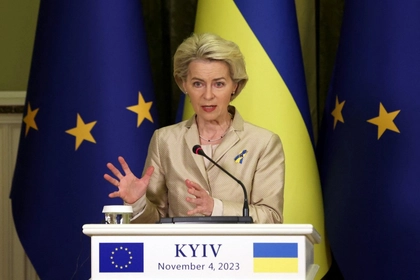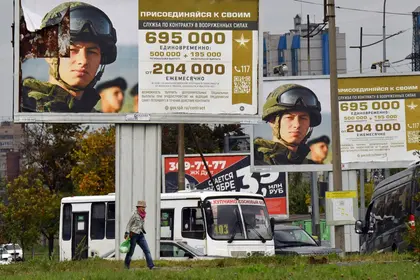Ukraine’s military announced on Tuesday that the milestone of Russian soldiers killed in action since the Kremlin’s Feb. 2022 invasion had reached 300,000. Circumstantial evidence supports the figure but just how accurate it actually is, is another question.
The Armed Forces of Ukraine (AFU) has published precise daily numbers for the Russian personnel its intelligence officers believe died in combat, or otherwise lost their lives, during the previous 24 hours.
JOIN US ON TELEGRAM
Follow our coverage of the war on the @Kyivpost_official.
However, the AFU does not facilitate independent checks of its estimates and the media is banned from the lines of contact. It only rarely allows independent observers to contact selected frontline troops and then under the supervision of an escort officer. To date, the AFU has refused to allow outside checks of its battlefield estimates, on grounds of security.
According to open-source reports and interviews held by Kyiv Post with army officers and enlisted personnel, the AFU daily data of “eliminated” Russian service personnel is mainly acquired through the study of video recordings by drones of Russian corpses lying on the ground.
To a much lesser extent the AFU will use confirmed casualty counts from Russian medical treatment centers, particularly civilian hospitals in the occupied territories and, in rarer cases, information gathered by its behind-the-lines agents.
AFU spokesmen have repeatedly claimed their methodology is rigorous and internally-checked, and that their estimated numbers of Russian dead – although impossible to compute with total precision in a total war – are as accurate as possible and very likely close to reality.

EU Transfers €1.5 Bln Raised From Russian Assets for Ukraine
According to official Ukrainian estimates the Russian army’s worst months for casualties were in March 2022 during the early weeks of the invasion, in Battle of Bakhmut the first half of 2023, and in recent weeks following massed frontal attacks on Ukrainian fortified defenses around the city Avdiivka
If the figure of 300,000 Russian soldiers dead over the past twenty months is accurate, then this represents not just a material and operational near-disaster for the Russian military, but a real body blow for Russian Federation demographics.
In a Monday post on his personal Telegram channel Anton Gerashchenko, a Ukrainian Interior Ministry advisor and one of the highest-profile Ukrainian spokesmen, portrayed what 300,000 corpses amounted to, in terms calculated to raise Ukrainian public spirit.
Three hundred thousand dead Russians, Gerashchenko informed readers of his blog, is:
- more than the sum total of every Roman soldier who served in every Roman Legion at the height of the Empire;
- is the equivalent of one Russian soldier being killed every three minutes;
- the number is such that, if laid end to end from Moscow to St. Petersburg, you could walk on corpses the whole distance without ever touching the ground;
- there are so many bodies that if they were to put into body bags and piled it neatly in Red Square, the stacks would cover the square completely in piles as tall as a man.
Some outside observers question the Ukrainian official and social media estimates. One of the most recent and detailed research papers on the subject, published by the European Center for Political Research (ECPR), estimated the Ukrainian either by accident or intentionally inflates the evidence it has on the number of Russian soldiers killed in combat by a factor of two.
France 24 news said that a joint investigation conducted by a Russian media outlet and a Germany-based data scientist using open-source Russian data in July, came up with the number of Russian service personnel killed in Ukraine at about one quarter the official Kyiv number.
Another source, the Russian government registry of inheritance claims, suggests that the Kremlin was most likely losing 2,500-3,000 troops in Ukraine each month in 2023.
If the rate of Russian military deaths since Feb. 2022 is based guesswork with estimates varying so widely, finding a trustworthy, and independently-checked estimate of Ukrainian casualties is nigh on impossible.
August comments to local media by Mykhailo Podolyak, a senior adviser to Ukrainian President Volodymyr Zelensky, restated the official Kyiv line that public announcements on Ukrainian casualty figures are the prerogative of the Army General Staff (AGS). The last time figures were given was in December when Podolyak said in a television interview that the Ukrainian military had lost 10-13,000 soldiers.
During periods of intense battle Ukrainian forces, particularly in fighting around Bakhmut in summer 2022, were estimated to be losing between 700 - 1,000 men and women a day. Since then, with the exception of a stalled offensive launched a year later, Ukrainian losses according to unit reports have been substantially less, but continuous nevertheless.
According to the ECPR report, the Ukrainian military over the first twelve months of fighting suffered around 75,000 combat casualties, of which about 17,000 probably died. The estimate roughly tallied with Podalyak’s comment two months earlier.
A paper prepared by the US Proceedings of the National Academy of Sciences (PNAS) explains that the higher ratio of Russian dead compared with those of Ukraine is in large part because Russian forces have been conducting a greater number of mass attacks in which there is an increased likelihood of soldiers getting hit. The greater difference between wounded and dead is because of superior Ukrainian battlefield medical support, both in the quality of medical equipment provided combined with the assigning of trained medics at lower unit levels and the preparedness of its leaders to put a brake on operations in order to evacuate casualties.
You can also highlight the text and press Ctrl + Enter






